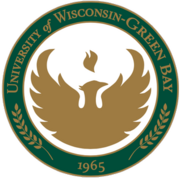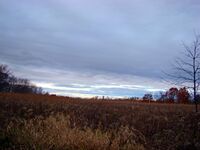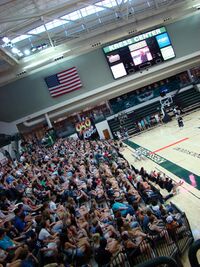University of Wisconsin–Green Bay
Topic: Organization
 From HandWiki - Reading time: 10 min
From HandWiki - Reading time: 10 min
 | |
| Motto | Ad Scientiam Renovandam[1][2] (Latin) |
|---|---|
Motto in English | "To Update Science" |
| Type | Public university |
| Established | 1965 |
Parent institution | University of Wisconsin System |
Academic affiliations |
|
| Budget | $130 million[3] |
| Chancellor | Michael Alexander[4] |
| Students | 9,870 (all four campuses) |
| Undergraduates | 9,278 |
| Postgraduates | 592 |
| Location | Green Bay , Wisconsin , United States [ ⚑ ] : 44°31′48″N 87°55′15″W / 44.53°N 87.92083°W |
| Campus | Midsize city[5] |
| Other campuses | |
| Newspaper | The Fourth Estate |
| |u}}rs | Green and white[6] |
| Nickname | Phoenix |
Sporting affiliations |
|
| Mascot | Phlash the Phoenix |
| Website | www |
The University of Wisconsin–Green Bay (UW–Green Bay, UWGB, or Green Bay) is a public university in Green Bay, Wisconsin, with regional campuses in Marinette, Manitowoc, and Sheboygan. Founded in 1965, it is part of the University of Wisconsin System. As of Fall 2020, student enrollment was approximately 8,970, including 8,531 undergraduate students.[7]
Since its founding, the school has had an environmental sustainability emphasis; it was nicknamed "Eco U" in 1971 by Newsweek.[8]). It offers associate, bachelor's, and master's degree programs, as well as a doctoral program, First Nations Ed.D. The university's mascot is the phoenix.
History
By 1958, the University of Wisconsin–Extension's Green Bay center had grown to 500 students, the second-largest of UW–Extension's eight freshman-sophomore centers. It grew to become the largest by 1965. Demand soon grew for a full-fledged four-year campus serving northeastern Wisconsin. In 1963, the Coordinating Committee for Higher Education unanimously recommended building a new university in the Fox Valley. Governor Warren Knowles, who was somewhat cool to the idea, proposed that the freshman-sophomore campuses in Green Bay and Kenosha be expanded to four-year institutions (the Kenosha institution eventually became the University of Wisconsin–Parkside). The bill was signed into law on September 2, 1965.[9]
UW–Green Bay officially came into being in the fall of 1968, with the first classes being held at the Deckner Center (now Anne Sullivan Elementary School), home of the former Green Bay extension center. It moved to its current location in the fall of 1969.[10]
In 2018, as part of a UW System restructuring that merged 13 two-year schools with seven four year schools, UW–Green Bay took responsibility for the former UW–Marinette, UW–Sheboygan, and UW–Manitowoc branches, turning them into University of Wisconsin–Green Bay Marinette, Sheboygan, and Manitowoc campuses.[11] In January 2024, Chancellor Alexander announced that the Marinette campus would move all instruction online.[12]
Academics
Originally, the university's two governing bodies, the College of Professional Studies and the College of Liberal Arts and Sciences supervised all academic programs, but the university put forth a restructuring plan in 2016 that divided the two into four new colleges.[13]
Austin E. Cofrin School of Business
Named for Austin E. Cofrin, a local philanthropist, the school was constituted in 2010 after Cofrin's son, David (who the campus library is named after) donated money to establish the program. Cofrin's donation was the largest for an academic program since the university's founding. The Cofrin School of Business oversees the accounting, business administration, and international business majors.
College of Arts, Humanities and Social Sciences
The CAHSS oversees the most majors of any of the university's four colleges, including all arts-related majors (both fine and performing), all humanities majors, all social science majors, the university's communication program, and the economics and information science programs.[14]
College of Health, Education and Social Welfare
The CHESW oversees the university's professional programs, including education, healthcare management, social work, and the joint nursing programs that the university maintains with the nearby Bellin College of Nursing.
College of Science, Engineering and Technology
The CSET oversees all science-related majors, in addition to mathematics and the university's Engineering Technology program.
Removal of interdisciplinary requirement
Until 2017, the university mandated that students complete at least one interdisciplinary major or minor in order to ensure a more well-rounded education. As an example, a student in a major classified as disciplinary, such as music, accounting, biology, or English was required to complete either a double major or a minor in a field with some professional applications considered interdisciplinary, such as business administration, communication, or computer science.[15] In late 2017, faculty members on the school's University Committee (of the Faculty Senate) proposed to remove the requirement in the interest of streamlining the academic process, a proposal that was controversial but ultimately passed.[16]
Top majors
The university's top majors, by degrees granted, are:[17]
Undergraduate:
- Business Administration
- Psychology
- Integrative Leadership Studies (an online-only BA/BS program targeted at non-traditional students)
- Human Biology
- Nursing (all tracks)
Graduate:
- Master of Social Work
- Master of Sustainable Management
Campus
The 200-acre campus is on the northeast side of the city of Green Bay, overlooking Lake Michigan's Green Bay body of water. Much of the campus is composed of natural areas, with the campus bordered on one side by the bay and on the other by the Niagara Escarpment.[18] A system of circular roads (North, East, and South Circle Drives) surrounds the central campus and are the main thoroughfares for traffic on campus, in addition to a few smaller roads that connect the Circle Drives with parking lots. The Cofrin Memorial Arboretum forms a natural boundary of 290 acres encircling the campus. It offers recreation, field trips, and research projects. The purpose of the Arboretum is to restore and preserve some of Wisconsin's native ecological communities and to offer an opportunity to enjoy and appreciate nature. It has more than six miles of trails open to the public.[19] The David A. Cofrin Library sits at the heart of campus, and is one of the tallest buildings in the Green Bay area.[20] Adjacent to the library in the central part of campus are all academic buildings, the University Union (UW–Green Bay's student union), and the Weidner Center for the Performing Arts. All of the university's residential buildings (with the exception of a female-only house adjacent to campus) are in the northeast part of campus, and include traditional residence halls, shared-bedroom apartments, and newer private bedroom apartments. The Richard Mauthe Center (formerly known as the Ecumenical Center) is just south of the residence halls and serves as the campus' religious center. The Mauthe Center is one of two buildings on campus that are run semi-independently of the university, the other being the Weidner Center. The Kress Events Center and various athletic fields dominate the southeast part of campus. A university-owned golf course, the Shorewood Golf Course, takes up the majority of the northern side of campus.[21]
Across Nicolet Drive, the road that forms the western border of the university, are two university-owned properties, Lambeau Cottage and Communiversity Park. Lambeau Cottage was owned by Green Bay Packers founder Curly Lambeau from 1941 to 1956, and was acquired by the state in 1978.[22] The building served many purposes, including a retreat center and headquarters for the sailing team, but fell into disrepair over time. In 2005, an alumnus provided a donation to restore the Lambeau Cottage, and it again finds itself typically used for university retreats.[23] Communiversity Park is a small park adjacent to the Lambeau Cottage and overlooks the bay.
Facilities
Weidner Center for the Performing Arts
The Weidner Center for the Performing Arts contains the 2,000-seat Cofrin Family Hall, the 200-seat Fort Howard Hall for recitals, the 99-seat-in-the-round Jean Weidner Theatre, and a dance studio.
David A. Cofrin Library
The Cofrin Library has a collection of more than one million items, and the Special Collections Department contains historical records of northeastern Wisconsin, genealogical records, and a local business archives collection. The library's top floor is home to university administration as well as viewpoints for notable landmarks within the area.
Kress Events Center
The Kress Events Center is the host for Phoenix Athletics, concerts, and university-wide events and is the headquarters for workouts, weight training, and intramural sports. The facility has an athletics training room, weight rooms, cardio deck, pool, racquetball courts, a climbing tower, outdoor playing fields, and a multipurpose gymnasium for basketball, volleyball and indoor tennis.
LeMieux Chapel
Joseph LeMieux was a stonemason who built lighthouses on the Great Lakes. His brother-in-law, Fabian LaPlant, was a carpenter. Together they teamed to build the LeMieux Chapel.[24]
Student housing
UW–Green Bay has 28 residential buildings, including traditional residence halls, apartment style residence halls, and student apartments. Approximately 2,000 students live on campus.[25]
Concourse 'tunnel' system
The UW–Green Bay main campus has a concourse system of underground corridors, casually referred to as "tunnels", that connect eleven of its buildings. Designed with the David A. Cofrin Library at its center, subterranean hallways branch out to Student Services, the University Union and seven academic buildings. Opposite the adjacent Theatre Hall and Studio Arts buildings that form an arts wing is a sciences wing comprises Instructional Services, Environmental Sciences and Laboratory Sciences buildings. To the west of the library are the L.G. Wood and John M. Rose Halls. Constructed in 2002, Mary Ann Cofrin Hall is the newest building in the concourse system. Campus buildings not connected by the concourse system are the residence halls, Kress Center, the Weidner Center, and the Brown County STEM and Innovation Center which broke ground September 17, 2018. In addition to helping faculty, staff and students navigate campus in adverse weather, the concourse system facilitates accessibility.
Activities
The student body participates in issues regarding university governance through the Student Government Association, which consists of an executive branch, a legislative branch, and a judicial branch (the Student Court).
Athletics
UW–Green Bay, which brands itself athletically as "Green Bay", is an NCAA Division I school and a member of the Horizon League.
The Green Bay women's basketball team has won or tied for the Horizon League regular-season championship twenty times.[26] The team has been to the NCAA tournament twenty times. It has also made two appearances in the Women's National Invitation Tournament (WNIT).
The team received its first national ranking in 2003, when it was ranked as high as #16 in both the Associated Press poll and the Coaches' Poll. In 2005, it also received a national ranking and a bid to the NCAA Tournament, but was knocked out in the first round by Maryland. In 2006, it appeared in the WNIT, where it lost to Iowa State in a first-round game. The next season, it was seeded #9 in the NCAA Tournament, where it defeated New Mexico in the first round before falling to top-seeded Connecticut in the second round. That loss ended their school record and nation-leading 26-game winning streak.
The next NCAA Tournament win for the Phoenix women came in 2010, when they entered as a #12 seed and upset 5-seed Virginia in the first round before bowing out to Iowa State on the Cyclones' home court just short of the Sweet 16. In the 2011 tournament, they entered as a #5 seed and made their first Sweet Sixteen appearance, defeating Arkansas–Little Rock and Michigan State before losing to regional top seed Baylor.
The Green Bay softball team claimed its first Horizon League tournament championship in 2005. It went on to the national tournament, where it defeated #5 seed Oregon State in the first round.
The Green Bay Women's Volleyball team claimed its first regular season Horizon League title and the first Horizon League tournament championship in 2018. The team went on to the NCAA DI tournament, losing to the #4 seed University of Wisconsin–Madison in the first round.
Notable alumni
Sports
- Kathi Bennett, basketball coach
- Tony Bennett, basketball player and coach
- Alec Brown, basketball player[27]
- Logan Vander Velden, basketball player
- Sandy Cohen, basketball player
- Keifer Sykes, basketball player
- Alfonzo McKinnie, basketball player
- Michael Schachtner, basketball player
- Jeff Nordgaard, basketball player
- Julie Wojta, basketball player
- Jessica Lindstrom, basketball player
- Allie LeClaire, basketball player and coach
- Mehryn Kraker, basketball player and coach
- Tosaint Ricketts, soccer player
- Horst Stemke, Olympic athlete
- Rob Davis, Dallas Cowboys assistant coach[28]
Politics and education
- James R. Charneski, Wisconsin State Representative
- Robert Cowles, Wisconsin State Senator
- Dave Hansen, Wisconsin State Senator
- Frank Lasee, Wisconsin State Senator
- Barbara Lawton, Lieutenant Governor of Wisconsin (attended)
- Sharon Metz, Wisconsin State Representative
- Kathleen E. Christensen, social scientist
- Romaine Quinn, Wisconsin State Senator
- Tyler Vorpagel, Wisconsin State Representative
- Ty Bodden, Wisconsin State Representative
Entertainment
- Nick Mortensen, comedian
- Mike Grell, comic book writer and artist
- Tony Shalhoub, actor (did not graduate)
- Kevin MacLeod, composer and musician
Business
- Mike Jackson, former Supervalu executive
- Jill Lajdziak, former general manager, Saturn
- Mark King, CEO of Taco Bell[29] and former president & CEO of TaylorMade.
Notable faculty
- Gregory S. Aldrete, Emeritus Professor of History and Humanistic Studies.[30]
- Herbert J. Grover, Wisconsin educator and politician, served as a professor in the 1990s.[31]
- Harvey J. Kaye, Emeritus Professor of Democracy and Justice Studies.[32]
- Michael Monfils, Mayor of Green Bay, served as adjunct Government faculty after leaving mayoral office in 1979.[33]
- Denise Sweet, Poet Laureate of Wisconsin (2004–2008); Associate Professor of First Nations Studies, at the university until 2011.[34]
References
- ↑ "A Latin motto: 'Ad Scientiam Renovandam' – Inside UW-Green Bay News". https://news.uwgb.edu/log-news/news/11/23/a-latin-motto/.
- ↑ Although officially adopted in 2009, the university's motto is rarely used.
- ↑ "Quick Facts-University of Wisconsin-Green Bay". https://www.uwgb.edu/about/quick-facts/.
- ↑ "Michael Alexander named new chancellor of UW-Green Bay". April 2, 2020. https://www.wisconsin.edu/news/archive/michael-alexander-named-new-chancellor-of-uw-green-bay/.
- ↑ "IPEDS-University of Wisconsin-Green Bay". https://nces.ed.gov/collegenavigator/?q=Green+bay&s=all&id=240277.
- ↑ "Institutional Colors - Marketing and University Communication - University of Wisconsin-Green Bay". Uwgb.edu. http://www.uwgb.edu/univcomm/toolkit/visual-identity/colors.asp.
- ↑ "Quick Facts - Marketing and University Communication - University of Wisconsin-Green Bay" (in en). http://www.uwgb.edu/univcomm/about-campus/profile.asp.
- ↑ "The History of Eco U™". University of Wisconsin-Green Bay. https://www.uwgb.edu/sustainability/explore-eco-u/eco-u%E2%84%A2-history/.
- ↑ "Chapter 2". Uwgb.edu. http://www.uwgb.edu/univcomm/GBhistory/FTBframes/chapt2.html.
- ↑ "Campus Profile - UW-Green Bay". Uwgb.edu. 1970-06-01. http://www.uwgb.edu/univcomm/about-campus/history2.htm.
- ↑ "UW System Board of Regents approves name changes for 2-year campuses" (in en). https://www.jsonline.com/story/news/education/2018/08/24/uw-system-board-regents-approves-name-changes-2-year-campuses/1085075002/.
- ↑ Greenberg, Susan (January 22, 2024). "UW Green Bay Marinette Campus to Move Online in the Fall" (in en). https://www.insidehighered.com/news/quick-takes/2024/01/22/another-wisconsin-branch-campus-move-online-fall.
- ↑ "Regents approve more dynamic administrative model for UW-Green Bay | Inside UW-Green Bay News" (in en-US). http://news.uwgb.edu/log-news/releases/12/14/regents-approve-more-dynamic-administrative-model-for-uw-green-bay-15128/.
- ↑ "Units & Programs - UW-Green Bay". https://www.uwgb.edu/cahss/units-programs/.
- ↑ "Interdisciplinary Majors and Minors < University of Wisconsin-Green Bay" (in en). http://catalog.uwgb.edu/undergraduate/planning/interdisciplinary-majors-minors/.
- ↑ "UW-Green Bay Faculty Senate Minutes, 12/13/17. 1-13.". http://www.uwgb.edu/sofas/structures/governance/senate/agendas/agenda%2012-13-17.pdf.
- ↑ "Quick Facts". University of Wisconsin-Green Bay. https://www.uwgb.edu/about/quick-facts/.
- ↑ "In-Depth Campus Profile - UW-Green Bay". Uwgb.edu. 2010-05-17. http://www.uwgb.edu/univcomm/about-campus/indepth.htm.
- ↑ "Cofrin Center for Biodiversity". Uwgb.edu. http://www.uwgb.edu/biodiversity/natural-areas/arboretum/.
- ↑ GmbH, Emporis. "Green Bay | Statistics | EMPORIS". https://www.emporis.com/statistics/tallest-buildings/city/100019/green-bay-wi-usa.
- ↑ "UW-Green Bay Campus Map". https://www.uwgb.edu/UWGBCMS/media/Maps/files/campus-map.pdf.
- ↑ "History | Packers Partenrship | University of Wisconsin - Green Bay" (in en). https://www.uwgb.edu/packers/history/.
- ↑ Seidl, Ace Eight of Spades - Justin. "Campus Compass - UWGB". http://www.uwgb.edu/campuscompass/sports/lombardi.html.
- ↑ "LeMieux Chapel is UWGB's hidden haven | Green Bay Press Gazette". greenbaypressgazette.com. 2012-05-12. http://www.greenbaypressgazette.com/article/20081001/GPG04/810010529/LeMieux-Chapel-UWGB-s-hidden-haven.
- ↑ "Ask GB". Uwgb.intelliresponse.com. 2008-01-17. http://uwgb.intelliresponse.com/undergrad/index.jsp?requestType=NormalRequest&source=4&id=484&question=What+types+of+housing+is+available+and+do+we+have+to+live+on+campus.
- ↑ "Horizon League - Raise Your Sights". http://horizonleague.cstv.com/sports/w-baskbl/spec-rel/110504aac.html.
- ↑ "Recent news on Alec Brown - Phoenix Suns". Rotoworld.com. http://www.rotoworld.com/recent/nba/2399/alec-brown/.
- ↑ "UW-Green Bay Continues to Seek Ways to Better Serve the Region - Inside UW-Green Bay News". https://news.uwgb.edu/phlash/releases/09/10/new-alumni-advisory-board-5720/.
- ↑ "Mark King". Yum! Brands. https://www.yum.com/wps/portal/yumbrands/Yumbrands/company/about-yum-brands/senior-officers-and-leadership-team/mark-king.
- ↑ "Gregory Aldrete - Faculty & Staff - Humanities - UW-Green Bay" (in en-US). https://www.uwgb.edu/humanities/faculty-staff/aldreteg/.
- ↑ Shively, Neil (January 8, 2010). "Where are they now? Bert Grover battling knee surgery complications". Wisopinion.com. http://www.wisopinion.com/index.iml?mdl=article.mdl&article=26634.
- ↑ "Faculty note: Prof. Emeritus Harvey Kaye explains radical speech by Pres. Roosevelt" (in en-US). https://news.uwgb.edu/phlash/faculty-staff/01/11/faculty-note-prof-emeritus-harvey-kaye-explains-radical-speech-by-pres-roosevelt/.
- ↑ "Mayors of Green Bay". 2012-05-12. http://www.ci.green-bay.wi.us/mayors_past/mayor_monfils.html.
- ↑ "The Poetry of Prof. Denise Sweet" (in en-US). https://news.uwgb.edu/featured/11/20/the-poetry-of-prof-denise-sweet/.
External links
 |
 KSF
KSF







